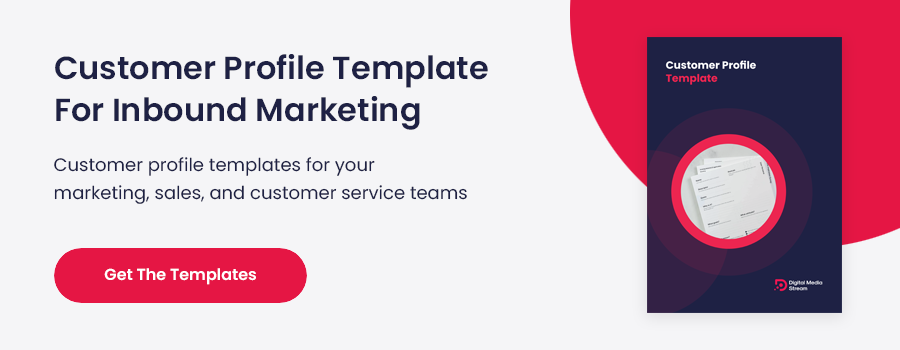You may have heard the terms ‘client profiles,’ ‘customer profiles,’ or ‘buyer personas’ brandished around and suspect that they have something to do with marketing.
These essentially all boil down to the same thing: your ideal customer.
A good buyer persona can keep your cost per conversion (CPC) down while increasing the customer’s lifetime value. Search Engine Land notes that “if it costs more than 25 per cent of your [Lifetime Value] to a close a buyer persona, something in your marketing needs to change.”
But exactly how important is it to create a customer profile for your ideal audience? The answer is that it’s very important with 71% of companies who exceed revenue targets using personas, and 90% of companies with personas understanding their target audience better.
With these stats in mind let’s quickly look at what exactly a client profile is.
A client profile (or buyer persona) is a semi-fictional representation of the ideal customer or customers you want to target. Client profiles help you determine via measurable steps who your target customer is and help you imagine the real person behind that mobile or computer screen.
Without knowing who that person is, it’ll be difficult for you to write content, create videos, or even send emails that your audience connects with. This means that when it comes time to buy, a potential customer may look elsewhere for a company that does connect with them personally.
As marketers, we actively work to avoid this happening. In our effort to support that, we want to share with your our five best practices when building client profiles.
1. Interview Your Best Customers or Clients
If you don’t have an understanding of your current customers, it can be hard to create a profile for potential new customers. Reach out to your best customers and ask them about themselves. They’ll (usually) be more than happy to share some insights and enjoy being regarded as a valued customer.
You’ll want to find out what makes them tick.
Ask about their background – what job do they have? How have they gotten to where they are in their careers? What is their biggest frustration day-to-day?
Other details you may want to include are their age, industry, hobbies, and location. Be careful to avoid overly personal questions - keep a respectful boundary. Avoid questions about gender identity, marital status and income.
You will also want to ask what a typical day looks like to them – what’s important to them? How do they handle themselves? What type of person are they? How does your product or service meet their needs or answer a problem they previously had?
Find out as much as you can about your customers. You can collate and analyse the data later. With this information, you should be able to more easily identify patterns and similarities between your existing customers, and start to preempt how to position yourself as the solution for common problems with new customers.
2. Consider Their Challenges
Now you know a little about this customer’s background, think about what challenges them. You may have a recruiter who wants to find the best candidates, but they worry about the competition. Does your company have a product or service that will set its recruitment agency apart?
Inc. Magazine provides a good explanation for why it's important to outline your potential customers' challenges or 'pain points'. They state that 'pain is a reminder that unless your prospect has a need to solve a problem, they are not going to buy a product'. They further explain that all purchases - even seemingly impulse buys - have an underlying reason. Understanding what problems your potential customers may need to solve helps you identify solutions your company can provide, and highlight them from the outset of any interaction.
How do you find out about your customer's challenges? Well, you can ask them for one.
You can also consider their challenges at the “Awareness Stage” - even though they may not be directly related to your business or product. It’s important that you understand those challenges to ensure you're providing content to match and capture those leads before they've even realised your business exists.
Think of the awareness stage as the research phase. If you are a recruitment company based in London and want to capture candidates searching for jobs - an awareness stage challenge might be affordable housing, with the resulting search term ‘how to find affordable places to live in London’.
Understanding these earlier awareness stage challenges is key to ensuring you can produce content to match and give yourself the opportunity to nurture prospects down the sales funnel.
3. Consider Non-Target Audiences
Most businesses, whether they know it or not, have people they don’t want to target. Those people may be one-time buyers, people who browse without purchasing, or people who would cost too much of your resources to acquire.
Think of who these people are and exclude them from your target audience. These are known as ‘negative personas’.
You want to speak only to those who are ready to buy or will be ready to buy after some nurturing. For example, if you’re an estate agent who sells or rents high-end luxury apartments, you wouldn’t want to target the student market.
HubSpot explains why it’s worth doing the legwork to understand those that won’t become customers. They suggest talking to those customers who had a low average spend or who provided negative feedback. Knowing who to target and who to exclude can help you hone your marketing message even more precisely, and prevent you from wasting time and resources reaching a less-than-ideal audience.
4. Examine How to Market to Each Audience
You may have an idea for one customer profile all the way to half a dozen, so you need to figure out how to market to each audience. What different messages will you write to target each member of each unique audience? There may also be messaging you can create that targets all of your personas at once.
For example, if you’re trying to sell perfume: you’ll either target prospects looking to buy the perfume themselves by marketing your product as exclusive and desirable, or you’ll target their partner who'll be looking to buy that product as a gift for their significant other. The messaging in your marketing materials will vary depending on the audience.
Consider who this audience is (and isn’t!) and how to reach them – in person, via social media, in print media, through blogs, via your website, and more.
5. Put Pen To Paper: Write Your Client Profile
Now you have an idea of who you’re targeting, what their pain points (problems) are, and how to market to them, it’s time to compose your client profile.
It’s important to create a formal document of who your target audience is as a way to ensure consistency; you can provide new writers, new salespeople and new marketers with a comprehensive outline of who they're talking to without needing to undergo the whole process every time.
If you asked all of the management team and the director(s) of your company who their ideal client is, would it be the same? If the answer is no - this is a great place to start.
OnBrand Magazine’s “State of Branding” Report explains that 72% of companies now realise the importance of building an audience – instead of taking a direct sales approach through online advertisements. In order to build an audience, you have to provide them with engaging content they want, build their trust, and earn their recognition.
Having your client profiles documented makes life easier for everyone in your business - trust us! Review and revise your client profiles routinely so that you’ll always know who you want to reach. After all, your target audience may change and evolve over time, particularly if you add new products or services to your business.
Now you know the best practices for building your client profiles, it’s time to get started. No matter your type of business, everything comes down to your target audience. If you don’t know who they are, everything you do may just be missing the mark.
How Exactly Do I Write a Client Profile?
If you’re unsure what to do next, we’re here to help. We have put together a handy guide to everything you need to understand about client profiles. Our guide also includes free templates so you can start creating your own profiles and personas straight away.
We’ll guide you through the process, step by step. Easy! Download your free copy of our Client Profile Template now.



Export_Customer-profiles-buyer-personas.jpg?width=352&name=PP002-%20Images%20(880%20x%20495)Export_Customer-profiles-buyer-personas.jpg)

